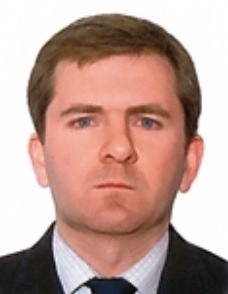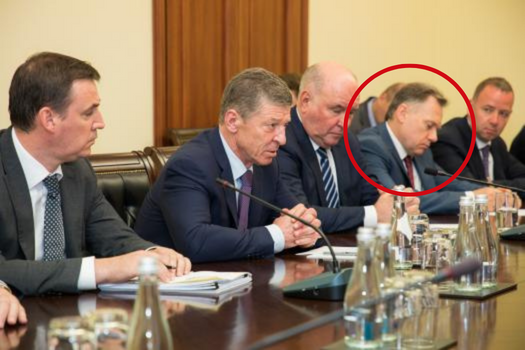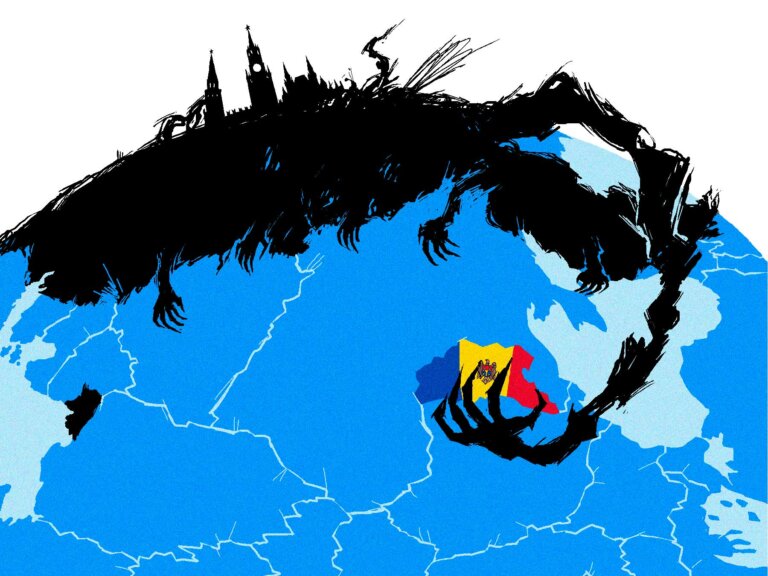According to the Dossier Centre and an international consortium of journalists, the Russian special services considered invading Moldova and opening a second front in Transnistria after their full-scale invasion of Ukraine. However, Russia eventually abandoned this plan and opted for a strategy of economic pressure, exploiting Moldova's gas reliance on Russia.
The London-based Dossier Centre, an investigative journalism organization founded by Russian opposition figure and anti-corruption activist Mikhail Khodorkovsky, together with Moldovan publication RISE (which also published a large article about the plan), Delfi, Kyiv Independent, Belarusian Investigative Centre, Yahoo News, Süddeutsche Zeitung, Westdeutscher Rundfunk, Norddeutscher Rundfunk, Expressen, Frontstory, and VSquare, studied the Russian presidential administration's strategy for "political and economic subjugation of Moldova," which was developed by the same team that created the strategy for Belarus.
The document was prepared by the Russian Presidential Office for Border Cooperation, the same office responsible for the plans to absorb Belarus by 2030, in cooperation with Russian special services and the General Staff. The source who passed the plan to journalists is fully confident that the document is genuine.
The strategy defines 2030 as the "deadline" for taking political control of Moldova and distancing it from its Western partners. Its objectives include:
- countering the influence of NATO and the EU on Moldova
- involving Moldova in the CSTO and other international projects under the auspices of the Russian Federation
- settling the Transnistrian conflict through Russian mediation by providing Transnistria a "special status"
- strengthening pro-Russian sentiment in society through information influence and educational programs.
The document shows that Russia had no plans for military intervention at the time. Instead, its main goals were to pressure Moldova over the Transnistrian issue. The Kremlin's plans included supporting pro-Russian political forces in Moldova and exploiting the country's dependence on Russian imports, particularly gas, to achieve its political goals.
For the latter, it was planned to maintain the existing volumes of gas supplies. The Kremlin hoped to maintain significant exports of Russian goods to Moldova and lobby for the interests of businesses from Transnistria and the autonomous region of Gagauzia, where pro-Russian sentiment is very strong.
The investigators note that Moldova's Russia-oriented political forces have voiced many points of the plan.
To expand its informational influence, Russia wanted to prevent restrictions on its resources and to create a network of loyal NGOs, such as the Moldovan-Russian Business Union, founded by former President Igor Dodon. The plan was to "discredit NATO" among Moldovans by 2025. Another medium-term goal was to "counteract Romania's expansionist policy in Moldova."
The Kremlin's next step would be to increase the electorate of pro-Russian Moldovan politicians, build pro-Russian sentiment among Moldovan elites, and prompt Moldova to abandon its policy of "Romanisation," a movement towards unification with Romania.
The plan was to "discredit NATO" among Moldovans by 2025. Another medium-term goal was to "counteract Romania's expansionist policy in Moldova."
"The goal is not to insidiously annex the country, but to strengthen pro-Russian influence in Moldova, primarily to prevent pro-NATO, pro-European trends. The Kremlin sees Moldova as a buffer to Russia rather than a part of the Russian Empire. As with Georgia, it is more about putting a stop sign to the West and preventing the country from joining the EU and NATO in every way possible," a Moldovan intelligence source told the journalists.
By 2030, the Kremlin hoped to increase the number of Russian media outlets, preserve the status of the language of interethnic communication in Russia, and "reduce the presence of third-country currencies" in settlements with Russia.
The spectre of the FSB haunts Moldova, next target of Russia’s hybrid war
For this, the Kremlin wanted to expand the number of Moldovan students in Russian universities in order to increase the presence of the Russian language, the Head of Office of the Prime Minister of Moldova Sergiu Diacanu told the investigators. According to him, the Kremlin wanted to ramp up its influence on the social and cultural spheres because it suffered a fiasco in the economic and military fields.
To expand its informational influence, Russia wanted to prevent restrictions on its media, but this failed: the Moldovan authorities closed 6 TV channels in 2022. It also wanted to create a network of loyal NGOs, such as the Moldovan-Russian Business Union, founded by former President Igor Dodon.
"Their strategic goal is to ensure that Moldova does not have control over its foreign policy. Even with the Kozak plan, which was proposed back in 2004, the idea was to say, 'Guys, we can give you gas, we can give you electricity, just let's make a federation [with Transnistria]. And this component of the federation, which is located on the left bank of the Dniester, will have the right to veto our foreign policy. Everything stems from there," explained the Prime Minister of Moldova, Dorin Recean.
Using the document, journalists identified two more people who are allegedly Russian "curators" for Moldova, in addition to the individuals who were the subject of a separate investigation in autumn 2022.

The source who handed over the document claims that the strategy was drawn up by Andrei Vavilov from the Kremlin's Office for Border Cooperation. Vavilov is allegedly a graduate of the FSB Academy and worked for the intelligence service for about 10 years before moving to the Kremlin.
Another alleged co-author of the document is Viktor Lysenko, deputy head of the Department for Interregional and Cultural Relations with Foreign Countries, where Vavilov used to work. His immediate superior is likely the deputy head of the Russian Presidential Administration, Dmitry Kozak
, with whom he has been working closely for about 10 years. Sources say that Lysenko "manually supervises Moldovan affairs."
Mobile phone billing records obtained by the Dossier Centre and RISE suggest that Lysenko regularly communicates with FSB General Dmitry Milutin, who is the intelligence services' "curator of Moldova." Between November 2021 and May 2022, they communicated at least ten times via open communication.

The Moldovan authorities have not commented on the authenticity of the document, but they have accused Russian intelligence services of trying to destabilize the country. In February 2022, Moldova expelled five Russian diplomats, including the deputy head of the Russian embassy, on suspicion of espionage. The Kremlin denied the allegations and responded by expelling five Moldovan diplomats.
Similar to earlier-revealed plans to conquer Belarus
The described plan dovetails Kremlin plans to take over Belarus by 2030, described by the Dossier Center and a similar team of international journalists, who reported on a similarly-titled document, "Strategic Goals of the Russian Federation on the Belarusian Direction."
Allegedly developed by the Russian presidential administration in cooperation with several intelligence and military agencies, the document indicated that the Kremlin sought to establish the dominance of the Russian language over the Belarusian language, adjust Belarusian legislation to Russian law, subjugate the socio-political, trade, scientific, and cultural life of Belarus, increase military presence in the country, and grant Russian citizenship to Belarusians.
The Union State, a political and economic alliance between Russia and Belarus, reportedly plays a significant role in the Kremlin's plans, as Russia intends to build up its forces in Belarus through it. The presidential administration was tasked with convincing the Belarusian leadership of the need to work on the Union State by the end of 2022. Additionally, Russian intelligence aims to limit the influence of "nationalist and pro-Western" forces, complete the reform of the Belarusian constitution in line with Russian interests, and consolidate pro-Russian sentiment in the military and political elites and among the population.
Other objectives include securing control over the information space of Belarus, opening exam centers for the unified state exam in Belarus, and opening new centers of science and culture in Mogilev, Grodno, and Vitebsk.
Several agencies allegedly developed the document, including the Foreign Intelligence Service, the FSB, the GRU (Main Directorate of the General Staff of the Russian Armed Forces), and the General Staff of the Russian Armed Forces. It was drafted by the Presidential Department for Border Cooperation, which intervenes in the politics of Belarus, Moldova, and the Baltic States. The department's curator is Dmitry Kozak, and the head of the department is Aleksei Filatov.
Putin has been exploiting Belarus to wage war against Ukraine, using it as a platform for attack and as a launching point for missile strikes against Ukraine. Although Lukashenka has not openly joined the war against Ukraine, he has supported Putin's actions, provided territory for Russian fighter jets and troops, conducted regular joint exercises on Belarusian soil, and threatened to enter the war if "Ukraine and NATO threaten Belarus." This dependence on Russia has made the Belarusian economy even more vulnerable to Western sanctions.
Lukashenka's visit to Russia in February 2022 highlighted the country's dependence on Russia. The Kremlin's long-term goal of achieving full control over Belarus remains in place despite the war in Ukraine slowing down its implementation.
Related:
- The spectre of the FSB haunts Moldova, next target of Russia’s hybrid war
- Ukraine notified Moldova about Kremlin’s plans to destabilize the situation in the country – Moldovian President
- “Very high” risk of Russian invasion in 2023 – Moldova’s Head of ISS

